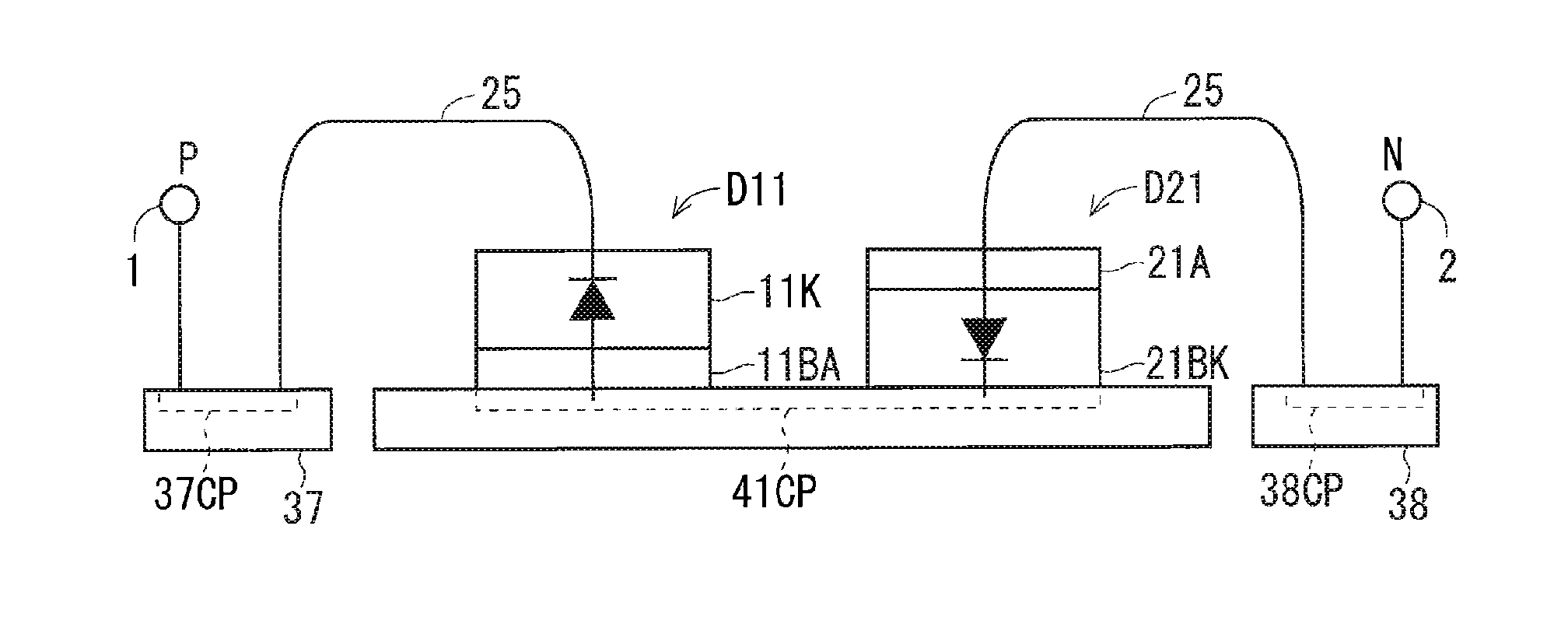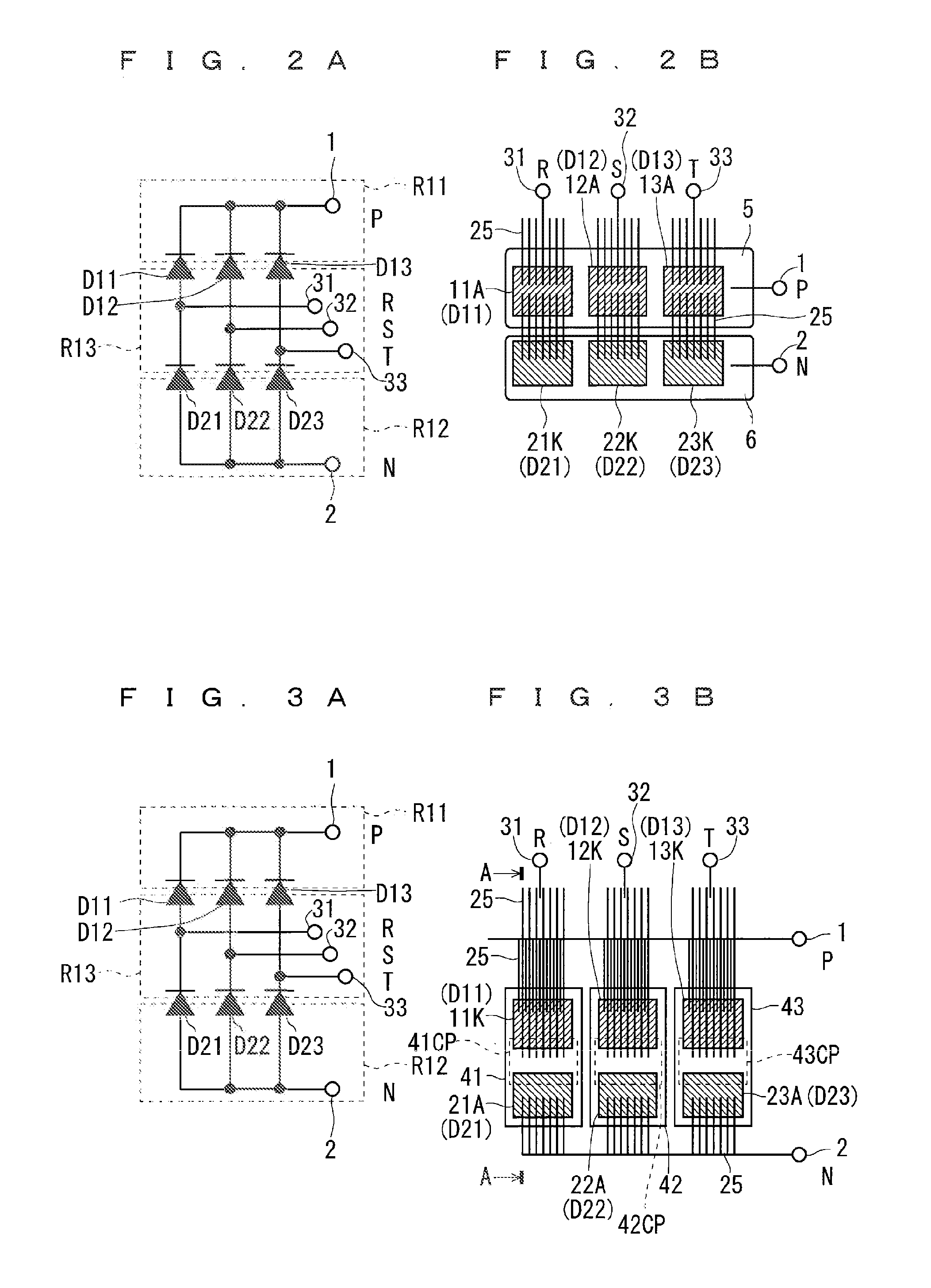Semiconductor device
- Summary
- Abstract
- Description
- Claims
- Application Information
AI Technical Summary
Benefits of technology
Problems solved by technology
Method used
Image
Examples
first preferred embodiment
[0042]FIGS. 2A and 2B are explanatory diagrams showing a configuration of a power module including a converter circuit according to a first preferred embodiment of the present invention. Hereinafter, only the minimum number of circuit patterns required is shown because a product may have a configuration that wires directly connect chips (semiconductor elements) to an electrode portion in some cases.
[0043]As shown in FIG. 2A, the converter circuit is formed of diodes D11 to D13 (first semiconductor elements) and diodes D21 to D23 (second semiconductor elements). The diodes D11 to D13 (a plurality of first diodes) include anodes (one first electrode regions) and cathodes (the other first electrode regions). The diodes D21 to 23 (a plurality of second diodes) include anodes (one second electrode region) and cathodes (the other second electrode regions). Specifically, each of the cathodes of the diodes D11 to D13 is connected in common to a P terminal 1, the anodes of the diodes D11 to ...
second preferred embodiment
[0069]FIGS. 3A and 3B are explanatory diagrams showing a configuration of a power module including a converter circuit according to a second preferred embodiment of the present invention. Hereinafter, only the minimum number of circuit patterns required is shown because a product may have a configuration that wires directly connect chips to an electrode portion in some cases.
[0070]As shown in FIG. 3A, the converter circuit is formed of the diodes D11 to D13 and the diodes D21 to D23 similarly to the first preferred embodiment.
[0071]FIG. 3B shows a specific configuration for achieving the converter circuit shown in FIG. 3A. In other words, common patterns 41 to 43 (common circuit patterns (first and second circuit patterns)) are provided as circuit patterns for the converter circuit. The common patterns 41 to 43 are formed independently of one another on a substrate, which is not shown, for example. The circuit patterns for the P terminal 1, the N terminal 2, and the intermediate ter...
third preferred embodiment
[0092]FIGS. 5A, 5B, and 5C are explanatory diagrams showing a configuration of a power module including a step-down chopper circuit according to a third preferred embodiment of the present invention. Hereinafter, only the minimum number of circuit patterns required is shown because a product may have a configuration that wires directly connect chips to an electrode portion in some cases.
[0093]As shown in FIG. 5A, the step-down chopper circuit in the power module of the third preferred embodiment is formed of a combination (module portion defined by a dashed line) of an N-type IGBT 51 (first semiconductor element) and a diode D20 (second semiconductor element) as the main portion. The IGBT 51 includes an emitter (one first electrode region) and a collector (the other first electrode region). The diode D20 includes an anode (one second electrode region) and a cathode (the other second electrode region). Specifically, the collector of the IGBT 51 is connected to a P terminal 101, the e...
PUM
 Login to View More
Login to View More Abstract
Description
Claims
Application Information
 Login to View More
Login to View More - R&D
- Intellectual Property
- Life Sciences
- Materials
- Tech Scout
- Unparalleled Data Quality
- Higher Quality Content
- 60% Fewer Hallucinations
Browse by: Latest US Patents, China's latest patents, Technical Efficacy Thesaurus, Application Domain, Technology Topic, Popular Technical Reports.
© 2025 PatSnap. All rights reserved.Legal|Privacy policy|Modern Slavery Act Transparency Statement|Sitemap|About US| Contact US: help@patsnap.com



